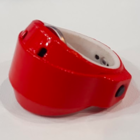Fujitsu was at the show to demonstrate its strength in big systems (big data, IoT and servers) as well as its client devices.
The company has previously explained to us the benefits of its “PalmSecure” security system which uses the pattern of veins in the user’s palm to authenticate. One of the advantages of the system is that the veins have to be connected to the circulation system, so palms can’t be “removed” (!). Another advantage is that Fujitsu can support the technology during boot, whereas many other systems based on fingerprints (or any in Windows Hello) need a lot of software to be loaded before authentication can be performed. It can also be supported by older software including Windows 7 and Windows 8.
The W10 is a new 13″ convertible/tablet that introduces PalmSecure to the tablet form factor. The tablet is for professional applications and will cost around €1,200 when it is officially launched in March. The company showed us the R726, which is a 12.5″ hybrid tablet/notebook that we are covering in this week’s product news. Staff highlighted to us that the R726 has been designed to allow in-house staff to repair faults. Many organisations are reluctant to send away notebooks for external repair when there is sensitive data on the mass storage.
The firm was showing the professional headset display that we reported on from BETT (BETT Roundup) and that it has been showing for more than a year. At MWC, this year, it was also showing a ring that could be used to control systems, including its headset, using gestures. The ring can be used to annotate images from the headset camera, or other images, or to operate the camera without touching the headset. The ring connects to the system using NFC and then switches to BLE for operation. Battery life is between half and one day, so for full day operation, multiple batteries need to be charged and carried (but they are very small).

